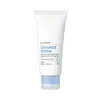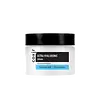What's inside
What's inside
 Key Ingredients
Key Ingredients

 Benefits
Benefits

 Concerns
Concerns

 Ingredients Side-by-side
Ingredients Side-by-side

Water
Skin ConditioningGlycerin
HumectantButylene Glycol
HumectantSqualane
EmollientPhenyl Trimethicone
Skin ConditioningPentaerythrityl Tetraethylhexanoate
EmollientDicaprylyl Ether
EmollientSucrose Polystearate
Emollient1,2-Hexanediol
Skin ConditioningGlyceryl Stearate
EmollientGlyceryl Stearate Citrate
EmollientCetearyl Alcohol
EmollientHydrogenated Polyisobutene
EmollientHydroxyethyl Acrylate/Sodium Acryloyldimethyl Taurate Copolymer
Emulsion StabilisingPropanediol
SolventXanthan Gum
EmulsifyingAcrylates/C10-30 Alkyl Acrylate Crosspolymer
Emulsion StabilisingPanthenol
Skin ConditioningGlyceryl Caprylate
EmollientTromethamine
BufferingEthylhexylglycerin
Skin ConditioningDisodium EDTA
Sorbitan Isostearate
EmulsifyingAllantoin
Skin ConditioningGlycine Soja Oil
EmollientBeta-Glucan
Skin ConditioningAcrylates/Stearyl Methacrylate Copolymer
Emulsion StabilisingCollybia Mushroom Extract
Hyaluronic Acid
HumectantUlmus Davidiana Root Extract
Skin ConditioningAngelica Archangelica Root Extract
MaskingRosa Multiflora Root Extract
Skin ConditioningCeramide NP
Skin ConditioningPhytosphingosine
Skin ConditioningHydrogenated Lecithin
EmulsifyingTocopherol
AntioxidantCanola Oil
EmollientRosmarinus Officinalis Leaf Extract
AntimicrobialWater, Glycerin, Butylene Glycol, Squalane, Phenyl Trimethicone, Pentaerythrityl Tetraethylhexanoate, Dicaprylyl Ether, Sucrose Polystearate, 1,2-Hexanediol, Glyceryl Stearate, Glyceryl Stearate Citrate, Cetearyl Alcohol, Hydrogenated Polyisobutene, Hydroxyethyl Acrylate/Sodium Acryloyldimethyl Taurate Copolymer, Propanediol, Xanthan Gum, Acrylates/C10-30 Alkyl Acrylate Crosspolymer, Panthenol, Glyceryl Caprylate, Tromethamine, Ethylhexylglycerin, Disodium EDTA, Sorbitan Isostearate, Allantoin, Glycine Soja Oil, Beta-Glucan, Acrylates/Stearyl Methacrylate Copolymer, Collybia Mushroom Extract, Hyaluronic Acid, Ulmus Davidiana Root Extract, Angelica Archangelica Root Extract, Rosa Multiflora Root Extract, Ceramide NP, Phytosphingosine, Hydrogenated Lecithin, Tocopherol, Canola Oil, Rosmarinus Officinalis Leaf Extract
Water
Skin ConditioningButylene Glycol
HumectantSodium Hyaluronate
HumectantBetaine
HumectantCaprylic/Capric Triglyceride
Masking1,2-Hexanediol
Skin ConditioningButyrospermum Parkii Butter
Skin ConditioningHelianthus Annuus Seed Oil
EmollientButylene Glycol Dicaprylate/Dicaprate
EmollientPEG-12 Dimethicone
Skin ConditioningHydrolyzed Jojoba Esters
Skin ConditioningGlycerin
HumectantSodium Polyacrylate
AbsorbentPvm/Ma Copolymer
Emulsion StabilisingCyclomethicone
EmollientBeeswax
Emulsion StabilisingGlyceryl Stearate
EmollientPEG-100 Stearate
Stearic Acid
CleansingDimethicone
EmollientSorbitan Stearate
EmulsifyingArachidyl Alcohol
EmollientBehenyl Alcohol
EmollientArachidyl Glucoside
EmulsifyingTriethanolamine
BufferingCarbomer
Emulsion StabilisingGlycyrrhiza Inflata Root Extract
Skin ConditioningPsidium Guajava Fruit Extract
AstringentMalpighia Emarginata Fruit Extract
Skin ConditioningAllantoin
Skin ConditioningAloe Barbadensis Leaf Extract
EmollientPortulaca Oleracea Extract
Skin ConditioningLilium Tigrinum Extract
Skin ConditioningCucurbita Pepo Fruit Extract
Skin ConditioningHydrolyzed Collagen
EmollientSnail Secretion Filtrate
Skin ConditioningDisodium EDTA
Limnanthes Alba Seed Oil
Skin ConditioningSqualane
EmollientOlea Europaea Fruit Oil
MaskingLeontopodium Alpinum Extract
Skin ConditioningMalva Sylvestris Flower Extract
Skin ConditioningBuddleja Davidii Extract
Skin ConditioningAloe Vera Callus Extract
AntioxidantCamellia Sinensis Callus Culture Extract
PerfumingChrysanthemum Indicum Callus Culture Extract
AntioxidantBambusa Vulgaris Callus Culture Extract
Skin ConditioningEthylhexylglycerin
Skin ConditioningParfum
MaskingWater, Butylene Glycol, Sodium Hyaluronate, Betaine, Caprylic/Capric Triglyceride, 1,2-Hexanediol, Butyrospermum Parkii Butter, Helianthus Annuus Seed Oil, Butylene Glycol Dicaprylate/Dicaprate, PEG-12 Dimethicone, Hydrolyzed Jojoba Esters, Glycerin, Sodium Polyacrylate, Pvm/Ma Copolymer, Cyclomethicone, Beeswax, Glyceryl Stearate, PEG-100 Stearate, Stearic Acid, Dimethicone, Sorbitan Stearate, Arachidyl Alcohol, Behenyl Alcohol, Arachidyl Glucoside, Triethanolamine, Carbomer, Glycyrrhiza Inflata Root Extract, Psidium Guajava Fruit Extract, Malpighia Emarginata Fruit Extract, Allantoin, Aloe Barbadensis Leaf Extract, Portulaca Oleracea Extract, Lilium Tigrinum Extract, Cucurbita Pepo Fruit Extract, Hydrolyzed Collagen, Snail Secretion Filtrate, Disodium EDTA, Limnanthes Alba Seed Oil, Squalane, Olea Europaea Fruit Oil, Leontopodium Alpinum Extract, Malva Sylvestris Flower Extract, Buddleja Davidii Extract, Aloe Vera Callus Extract, Camellia Sinensis Callus Culture Extract, Chrysanthemum Indicum Callus Culture Extract, Bambusa Vulgaris Callus Culture Extract, Ethylhexylglycerin, Parfum
Ingredients Explained
These ingredients are found in both products.
Ingredients higher up in an ingredient list are typically present in a larger amount.
1,2-Hexanediol is a synthetic liquid and another multi-functional powerhouse.
It is a:
- Humectant, drawing moisture into the skin
- Emollient, helping to soften skin
- Solvent, dispersing and stabilizing formulas
- Preservative booster, enhancing the antimicrobial activity of other preservatives
Allantoin is a soothing ingredient known for its protective and moisturizingg properties. Because of this, it is often added to products with strong active ingredients.
Studies show higher concentrations of this ingredient can promote wound healing.
Though it can be derived from the comfrey plant, allantoin is produced synthetically for cosmetic products to ensure purity.
Learn more about AllantoinButylene Glycol (or BG) is used within cosmetic products for a few different reasons:
Overall, Butylene Glycol is a safe and well-rounded ingredient that works well with other ingredients.
Though this ingredient works well with most skin types, some people with sensitive skin may experience a reaction such as allergic rashes, closed comedones, or itchiness.
Learn more about Butylene GlycolDisodium EDTA plays a role in making products more stable by aiding other preservatives.
It is a chelating agent, meaning it neutralizes metal ions that may be found in a product.
Disodium EDTA is a salt of edetic acid and is found to be safe in cosmetic ingredients.
Learn more about Disodium EDTAEthylhexylglycerin (we can't pronounce this either) is commonly used as a preservative and skin softener. It is derived from glyceryl.
You might see Ethylhexylglycerin often paired with other preservatives such as phenoxyethanol. Ethylhexylglycerin has been found to increase the effectiveness of these other preservatives.
Glycerin is already naturally found in your skin. It helps moisturize and protect your skin.
A study from 2016 found glycerin to be more effective as a humectant than AHAs and hyaluronic acid.
As a humectant, it helps the skin stay hydrated by pulling moisture to your skin. The low molecular weight of glycerin allows it to pull moisture into the deeper layers of your skin.
Hydrated skin improves your skin barrier; Your skin barrier helps protect against irritants and bacteria.
Glycerin has also been found to have antimicrobial and antiviral properties. Due to these properties, glycerin is often used in wound and burn treatments.
In cosmetics, glycerin is usually derived from plants such as soybean or palm. However, it can also be sourced from animals, such as tallow or animal fat.
This ingredient is organic, colorless, odorless, and non-toxic.
Glycerin is the name for this ingredient in American English. British English uses Glycerol/Glycerine.
Learn more about GlycerinGlyceryl Stearate is a mix of glycerin and stearic acid.
It is used to stabilize the mixing of water and oil ingredients. By preventing these ingredients from separating, it can help elongate shelf life. It can also help thicken the product's texture.
As an emollient, it helps soften skin and supports barrier-replenishing ingredients.
In cosmetics, Glyceryl Stearate is often made from vegetable oils or synthetically produced.
This ingredient may not be fungal-acne safe
Fun fact: The human body also creates Glyceryl Stearate naturally.
Learn more about Glyceryl StearateSqualane is an emollient that helps the skin hold onto moisture. It's an oily liquid that occurs naturally in certain types of fish and plant oils.
Because squalane boosts hydration in the skin, it also comes with plenty of benefits: it is an antioxidant and can help fight free radicals and skin damage. Squalane is also found to have a detoxifying effect when applied.
Squalane comes from squalene, which occurs naturally within the sebum of our skin. It is one of the oils our skin produces to keep itself hydrated. Squalane is the hydrogenated version of squalene and has a longer shelf life.
Research shows that squalane is non-irritating (even at 100% concentration).
In general, it's a fantastic ingredient. It does a great job at hydrating the skin, and it's suitable for those with sensitive skin.
The source of squalane may impact malassezia / fungal acne. This is because olive oil derived squalane can contain impurities such as fatty acids and plant waxes. Sugarcane derived squalane is recommended for anyone with malassezia concerns.
Is squalane vegan?
This depends on the source. Squalane can be derived from both plants and animals. Most squalane used in skincare comes from plants.
Please note: the source of squalane is only known if disclosed by the brand. We recommend reaching out to the brand if you have any questions about their squalane.
Read more about squalene with an "e".
Is squalane an oil?
Squalane is often called an oil, but it’s technically not; it’s a hydrocarbon, meaning it’s only made of carbon and hydrogen, unlike true oils which are triglycerides made of fatty acids and glycerol.
The term “oil-free” isn’t regulated, so companies can define it however they want. Some exclude all oils, while others just avoid mineral oil or comedogenic oils.
While some people avoid oils thinking they cause breakouts, the right kind of oil (or oil-like ingredient like squalane) can actually help balance and hydrate your skin. It’s worth testing out simple oils or squalane to see what works best for your skin.
Learn more about SqualaneWater. It's the most common cosmetic ingredient of all. You'll usually see it at the top of ingredient lists, meaning that it makes up the largest part of the product.
So why is it so popular? Water most often acts as a solvent - this means that it helps dissolve other ingredients into the formulation.
You'll also recognize water as that liquid we all need to stay alive. If you see this, drink a glass of water. Stay hydrated!
Learn more about Water